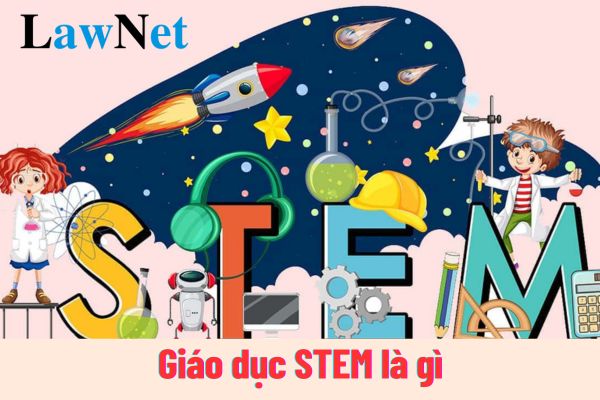What is STEM Education? In Vietnam, what is the educational level at which STEM Education is taught?
What is STEM Education?
According to sub-section 1, Section 2 of Official Dispatch 909/BGDDT-GDTH 2023 guiding the content of STEM education:
Content of STEM Education
STEM education is an educational approach primarily based on integrated teaching, providing opportunities for students to mobilize and aggregate knowledge and skills in the areas of Science, Technology, Engineering, and Mathematics to develop qualities, competencies, and effectively solve practical life problems.
In implementing STEM education, integration of arts and humanities (Art) is encouraged in some subjects/educational activities in the curriculum to expand and enhance the effectiveness of practice education, cooperation in various ways to promote creativity, aesthetics, curiosity, and empathy of students (implementing STEAM education).
Thus, STEM education is an educational approach primarily based on integrated teaching, providing opportunities for students to mobilize and aggregate knowledge and skills in the areas of Science, Technology, Engineering, and Mathematics to develop qualities, and competencies, and effectively solve practical life problems..
Students and teachers may refer to the following information about STEM education:
|
What is STEM Education?
|
Note: Information is for reference purposes only./.

What is STEM Education? In Vietnam, what is the educational level at which STEM Education is taught? (Image from the Internet)
In Vietnam, what is the educational level at which STEM Education is taught?
According to sub-section 1, Section 2 of Official Dispatch 909/BGDDT-GDTH 2023 guiding the content of STEM education at the primary education level as follows:
Content of STEM Education
STEM education is an educational approach primarily based on integrated teaching, providing opportunities for students to mobilize and aggregate knowledge and skills in the areas of Science, Technology, Engineering, and Mathematics to develop qualities, competencies, and effectively solve practical life problems.
In implementing STEM education, integration of arts and humanities (Art) is encouraged in some subjects/educational activities in the curriculum to expand and enhance the effectiveness of practice education, cooperation in various ways to promote creativity, aesthetics, curiosity, and empathy of students (implementing STEAM education).
Thus, according to the above regulations, STEM education is taught at the primary education level.
What are the regulations on organizing STEM education at the primary education level in Vietnam?
According to sub-section 2, Section 2 of Official Dispatch 909/BGDDT-GDTH 2023 guiding the methods of organizing STEM education at the primary education level as follows:
(1) STEM Lessons
Teaching subjects through STEM lessons is an organizational method that implements intra-disciplinary or interdisciplinary integration. This is the primary implementation form of STEM education in schools to effectively execute the primary education curriculum.
The content and requirements of STEM lessons align closely with the requirements of the subjects/educational activities in the primary education curriculum. The duration of implementing STEM lessons is established based on the duration of the subjects/educational activities related to the STEM lesson scientifically, flexibly, suitable to the psychological age of students, without overloading students and teachers, and is reflected in the school's educational plan as per regulations.
The process of implementing STEM lessons is based on the technical design process or scientific exploration process with learning activities suitable for students and using primary education teaching equipment as regulated by the Ministry of Education and Training along with students' learning supplies in subjects/educational activities, and easily available materials for teachers and students. Digital supplemental resources such as virtual experiments, simulations, and software are encouraged for use, and accessible in and out of the classroom to foster student autonomy in learning.
Student assessment in STEM lessons is conducted as per the regulations on testing and evaluation following the primary education curriculum. Based on the requirements for achieving STEM lessons, teachers assess students using primary methods such as observation, questioning, and evaluation through learning portfolios, and students' products and activities. When assessing, it is important to focus on process assessment (continuous evaluation) to motivate student progress, and build confidence and enthusiasm for learning in students.
(2) STEM Experiential Activities
STEM experiential activities involve organizing STEM education activities through STEM clubs, STEM festivals, STEM learning projects or STEM experiential activities in reality at appropriate locations based on students' goals, interests, talents, and aspirations to create excitement and motivation for learning, contributing to the development of competencies, qualities, and nurturing passion and talent in students. STEM experiential activities are developed in the school's educational plan, suitable to the educational institution's and local realities.
STEM experiential activities are designed based on interdisciplinary integrated teaching, covering many areas requiring students to mobilize comprehensive knowledge and skills to propose solutions to effectively, flexibly, and creatively solve practical problems.
The space and time for conducting STEM experiential activities may extend beyond the school space (production facilities, universities, research institutes, etc.), and outside regular subject/educational activity hours.
(3) Introduce to Scientific and Technical Research
Introducing scientific and technical research is a form of organizing STEM education activities for students with talents, interests, and initial excitement in exploring and accessing scientific and technical research to solve practical problems.
Through organizing STEM lessons and STEM experiential activities, teachers identify talented students to foster and create favorable conditions for them to familiarize with scientific and technical research.
Educational institutions organize STEM education activities to provide opportunities for students to get acquainted with scientific and technical research in the form of individual or group projects/research topics, guided by a teacher, a group of teachers, or cooperation with other relevant social forces related to the research content (such as families, production facilities, universities, research institutes, science centers, experts, artisans, scientists...).
Based on practical conditions, educational institutions may organize STEM experiential activities, scientific and technical research exchange festivals at the unit as a basis for selecting research topics/projects to participate in scientific and technical research playgrounds suitable for primary school students.

